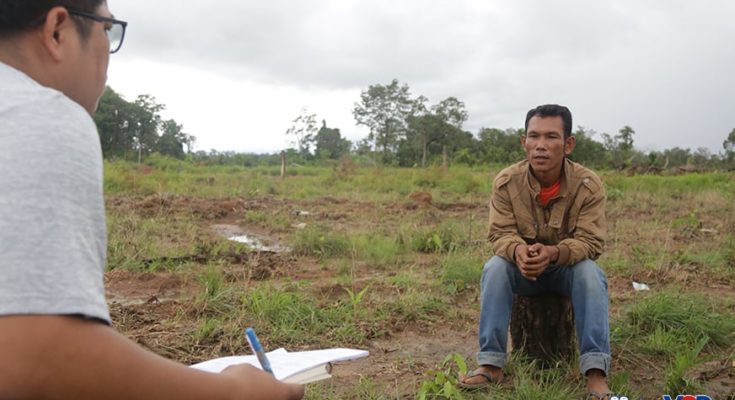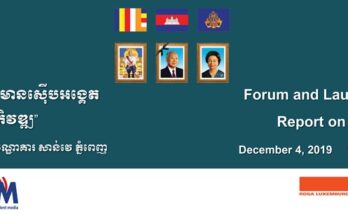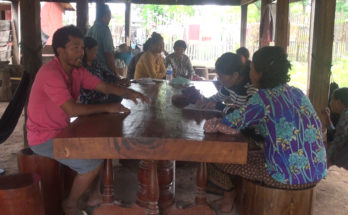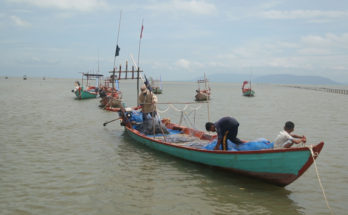Rich in fertile laterite soil, Ratanakiri province is covered with rubber, cashew, and durian plantations as well as other crops and is home to many indigenous people (IP) who account for half of the province’s total population.
Some agro-industrial plantations are being occupied by individual outsiders who are not local indigenous people, and other thousands of hectares of plantations are owned by private companies receiving the land plots under the Royal Government’s economic land concession (ELC) policy.
Large plantations of agro-industrial crops along National Road No. 76 linking Banlung City with Lumphat District have shown remarkable economic changes in the northeast province, and this is consistent with the government’s strategy that states that the ELC policy is intended to improve and maintain economic growth as well as expedite efforts to reduce the people’s poverty.
However, the Tumpoun indigenous people from three communities in Seda commune, Lumphat district who had already suffered in land disputes express their concerns over the adverse impact of agricultural chemicals on their health after the arrival of those ELC companies and their development activities.
The impact of agricultural chemicals on the health of the indigenous people in the area may not help contribute to the reduction of people’s poverty as envisioned by the government after banned chemical fertilizers are being used in the area.
Ratanakiri ranked the second largest coverage area of ELC after Kratie
A report on ELC compiled by a local human rights group shows that 2.6 million hectares of land, equivalent to 14 percent of the country’s total land area have been granted to local investors and foreign-owned companies as ELC for agro-industrial development from 1995 to 2015.
Moreover, data compiled by Open Development Cambodia (ODC) has shown that there are 286 locations of ELCs across the country, which are being operated by 270 companies including foreign companies, many of which are Chinese and Vietnamese companies. However, the total size of the ELCs has been reduced to just over 2.188 million hectares after the government decided to reduce the size of individual ELCs in 2015.
The ODC data has also shown that 242,898 hectares of land in Ratanakiri, approximately 22.52 percent of the province’s total land area of 10,782 square kilometers have been granted to private investment companies. Those private companies have occupied 35 ELCs in the entire province, which makes it rank second after Kratie province as the province with most locations of ELCs in Cambodia.
In Lumphat district, some 60 kilometers south of Banlung city, according to the ODC data, there are seven companies owning more than 175,000 hectares of ELCs, or over 72 percent of the total size of ELCs in Ratanakiri province as a whole that the government has granted to private investors.
The ODC data did not indicate the communes where the ELCs of the seven companies are located in Lumphat district, but there is one company, namely Kao Su Ea Lev MB JSC Ltd., that has been found to have received 8,400 hectares of ELC in Seda commune in 2011. This company is owned by Vietnamese investor Le Van Thuan who has been granted ELC for rubber plantations, but the duration of the investment contract is unknown.
A report from the Cambodian Center for Human Rights (CCHR), however, has indicated that Rat Sokhorn Incorporation Ltd, owned by Oknha RAT Sokhorn, president of the VOVINAM Sport Federation and director of Hollywood International Film Academy based in the United States, was granted 9,000 hectares of ELC in Seda commune as well in 2012 for rubber plantations for 70 years.
Tumpoun in Ratanakiri live with their customs and traditions
While Cambodia’s total population is estimated to be around 15 million, the country has approximately 200,000 indigenous people being divided into 24 different groups. They are equivalent to 1.2 percent of the country’s total population. Majority of the indigenous groups concentrate in the northeastern and southern provinces of the country. Of all the indigenous groups, the Tumpoun indigenous group is the biggest with an estimated population of 30,000, most of them inhabiting in the provinces Ratanakiri and Mondulkiri.
A report from the NGO Forum on Cambodia reveals that all indigenous people together occupy some 4 million hectares of land all over the country.
Tumpoun villagers have similar customs and traditions like other indigenous groups. Their livelihood depends on animal husbandry and rotational farming. Furthermore, they also count on income from the harvesting of non-timber forest products (NTFP) as well as traditional weaving. Tumpoun people depend on the forest to sustain their livelihood without land and forest clearances as these have been preserved by their generations of ancestors. They show firm solidarity and strict respect for their traditions and spiritual beliefs that they believe protect both human beings and animals and bring them high yields.
Like for the dominant Khmer population, the rights of all indigenous peoples in Cambodia are protected by the constitution or separate policies of the country. Communal title rights of the indigenous peoples are protected by Articles 23 to 28 of the 2001 land law.
The country’s indigenous population has also been supported by the policy on the indigenous community development adopted in 2009 by the Cambodian government. The policy is intended to improve the living conditions of the indigenous communities and enhance their quality of life through the development of the ten sectors culture, education and vocational training, health, environment, land, agricultural and water resources, infrastructure, justice, tourism, and industry, mines and energy.
IP express concern over their health after many cattle died, suspecting of poisoning
The Tumpoun people from three communities in Seda commune have claimed that a number of their cattle had died over the past two years, suspected of being poisoned with chemical substances used in the nearby economic land concessions.
Mr. Srot Mok, Tumpoun villager from Keng San village, said cows and buffalos are the main food for the communities to hold indigenous ritual ceremonies as well as other traditional gatherings and the cattle of both types are also important for agriculture.
He said he saw the cattle in the communities dying since 2017, and he and other members of the community believe that the cattle had been poisoned by the chemicals being used for killing grass and sprayed on crops within the land concession about five kilometers away from the community.
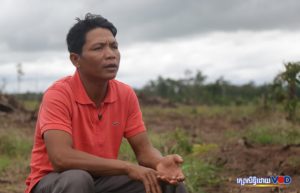
Mr. Srot Mok said, “The cattle die of the chemicals. They drink water and get sick with a swollen stomach and diarrhea and then they die. Some people know that the cattle have died of the chemicals. In the past, when there were no plantations yet, nobody had sprayed the chemicals yet, our cattle did not die. Now, they come to do the plantations, they spray chemicals and our cattle drink water and graze on grass fields affected by the chemicals, then they die. The cattle become sick with a swollen stomach and diarrhea with blood, twist their body and they die quickly. Now, in some days, five cattle died. In some cases, the cattle become too weak and they collapse.”
Similar cases have already occurred in Samot Leu village, about three kilometers from Keng San village, and in Samot Kraom village, located southeast of Lumphat Wildlife Sanctuary and bordering Koh Nhek district of Mondulkiri province.
Another Tumpoun villager, Mr. Lat Branh, 39, from Samot Kraom village, said the indigenous villagers generally herd their cattle on the grass fields and forest pastures and sometimes the cattle enter the economic land concessions.
The same Tumpoun villager claimed that the deaths of the villagers’ cattle that the villagers suspected may have been caused by poisonous chemicals also occurred in his community.
He said the villagers could only suspect that the cattle may have died of the chemicals used in the economic land concessions, but they could not find any solution with the company, which owns and operates the economic land concession.
“There are cases of cattle dying, indeed. We suspect that [chemicals are the cause] but we don’t know [for sure] and we cannot just accuse them,” said Mr. Lat Branh.
During discussions with his community members in May, Mr. Tuy Nheb, leader of the Tumpoun indigenous community in Samot Leu village, elaborated on how the economic land concession impacted traditional livelihoods of the indigenous people following the arrival of and the land clearance by the private company that received the economic land concession nearby his community.
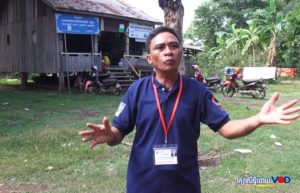
“In the past, the daily life of the community was better. Now, it is difficult. In the past, the community had enough forest on which their livelihood depends as the found vines, mushrooms and so on there, and now there’s no more forest. The company has taken it and nothing is left nowadays. In earlier years, [before the company’s arrival], we did not have any problem. The community could find things nearby the village,” said Mr. Tuy Nheb.
When asked about suspected cases of cattle being poisoned by chemicals, the community leader claimed that many cattle of the villagers died last year and that the community members suspected that the cattle may have been poisoned by the agricultural chemicals being used in the economic land concessions.
Mr. Tuy Nheb added that his community members have now become even more worried about the impact on their health after their cattle died in large numbers, the case many suspected may have been caused by the poisonous chemicals being used to remove grass in the upstream economic land concessions.
Mr. Tuy Nheb said, “[…] Nowadays, the two companies [Mang Yang K and Kao Su Ea Lev] both have impacts. For example, they [the companies] are in the upstream and the communities are in the downstream area, and when they spray chemicals to remove grass in their rubber or cashew plantations, there is an impact. The chemicals get into the stream and affect the downstream communities. Nowadays, chickens, ducks and cattle are no more. [They have all died]. And in the future, we don’t know if this will impact us human beings, too. [Now, there’s no impact yet on human beings?] No, no. Not yet. The impact only affects animals.”
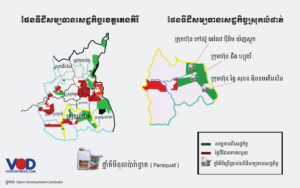
Authorities deny alleged deaths of cattle due to agricultural chemicals this year
Local authorities in Lumphat district have denied alleged deaths of cattle due to chemicals this year, but acknowledged that there were cases of villagers’ cattle dying two years ago.
The chief of Keng San village Mr. Nhorng Angkut said he has not seen cases of villagers’ cattle dying of poisonous chemicals so far this year, adding that no villagers have ever reported such a case.
However, the village chief said some cattle of Tumpoun indigenous people in Keng San village died in 2016 and that he reported the cases to the vet officials in Seda commune and Lumphat district while stating that he did not know the cause of the cattle’s deaths.
Mr. Nhorng Angkut said, “No. No sick cattle! There were but in the past year, not this year. I don’t see this. If there was, people would tell me. I don’t know. I did not hear anything. There was a case where one cattle dies. That’s normal. In the year before last year [2016], many cattle died, but I don’t know how many. It was two years ago. There were four or five cattle dying, both cows and buffalos, but it was not too many. It was long time ago and I [reported it] to the commune and district vet officials. I don’t know the cause of the deaths at that time. Whether it was caused by a disease or insect bites, we don’t know for sure.”
Mr. Sar Theary, Deputy Director of Office of the Ratanakiri Provincial Department of Agriculture, Forestry and Fisheries, said he did not know about the alleged deaths of cattle of the Tumpoun villagers due to chemicals, adding that no local official reported such a case to him.
Mr. Sar Theary said, “I have not heard of the news at all. Neither district officials nor commune officials have ever reported this to me.”
Containers and bottles of banned chemicals found by the villagers in the ELCs
Although he said he didn’t know about the alleged deaths of the cattle of Tumpoun indigenous villagers due to poisonous chemicals, Mr. Sar Theary expressed his opinion that if there were indeed deaths of cattle, those cattle may have died of poisonous chemicals used to remove grass in the plantations.
Mr. Sar Theary added that, “Mostly, they use chemicals to remove grass. The chemical substance is Glyphosate. Here, they grow cassava so they remove the grass around the base of the cassava stems.”
The agricultural official said he and his team went to visit the area to check the chemicals and agricultural fertilizers being imported, distributed and used in Ratanakiri and found that most of the chemicals and agricultural fertilizers being distributed and used within his territory of jurisdiction were legal and properly labeled with how-to-use instructions in Khmer.
Mr. Sar Theary added, “We often conduct field visits to the districts to see if the chemicals imported, sold and used are properly registered, and mostly we have found that the chemicals are properly registered and have proper Khmer labels with instructions.”
However, emptied containers and bottles of a chemical substance called Paraquat have been found in parts of the economic land concessions, which was suspected to be illegally imported and used.
The emptied containers and bottles of the chemical substance Paraquat, which were found by Tumpoun indigenous villagers, are with Thai-language labels, proving that these are made in Thailand. Paraquat, with the chemical formula C12H14Cl2N2, is one of 116 types of chemicals being banned by the Ministry of Agriculture, Forestry and Fisheries, from being imported, distributed and used in Cambodia.
The presence of emptied containers and bottles of the banned chemical substance has raised the question as to how and by who this kind of chemical substance is imported, distributed and used.
Mr. Suong Tev, Chief of the Legislation Bureau of the Ratanakiri Provincial Department of Agriculture, Forestry and Fisheries, acknowledged that a small number of chemical substances has been illegally imported into Cambodia from neighboring countries through border crossing points that are not under his officials’ competence.
Mr. Suong Tev said, “I tell you honestly. In Vietnam, there are some chemical substances that are legal, and a small number of substances has continued to be imported into [our country], but this is just in very small number. We also monitor this infiltration and we take strict measures of surveillance and monitoring in this regard as well.”
According to the report on the import of agricultural chemicals and fertilizers, which falls under the jurisdiction of the department of agricultural legislation of the Ministry of Agriculture, Forestry and Fisheries, among the seven ELCs in Lumphat district, only one company, Daun Penh Agrico Co., Ltd, applied for the importation of the chemical substance Glyphosate from the brand Helosate 48SL at the amount of 77 tons from Vietnam in 2014 for use in the ELC located in Chey Oudom commune. Since then, no new application from this company has ever been filed.
When contacted by phone, Mr. RAT Sokhorn, president of Rat Sokhorn Incorporation Co., Ltd., which was granted 9,000 hectares of ELC in Lumphat district, part of it covering Seda commune, refused to give the details of the development activities as well as chemicals and agricultural fertilizers being used in his ELC, saying that he has transferred the economic land concession to another investment company.
VOD was unable to seek comments from Jing Zhong Ri Co., Ltd., owned by Chinese investor Li Qing Xian and Kao Su Ea Lev BM JSC Ltd of Vietnamese investor Le Van Thuan, both of which own and operate a large share of ELCs in Seda commune, on the details about the development activities within their ELCs as the companies could not be found by the addresses indicated in their applications for the ELCs.
VOD has also sought most up-to-date data on companies owning ELCs in Lumphat district from the Ministry of Agriculture, Forestry and Fisheries but as of August 14, the Ministry has not replied to VOD’s request for information.
The use of chemicals and agricultural fertilizers in ELCs has been put under the scrutiny of a regular monitoring mechanism of the Ministry of Agriculture, Forestry and Fisheries and its subordinate institutions.
Head of Legislation Bureau of the Ratanakiri Provincial Department of Agriculture, Forestry and Fisheries, Mr. Suong Tev, added that his team visited two ELCs in Kaun Mom and Veun Sai districts, but he said he and his officials did not check the use of agricultural chemicals in the ELCs in Seda commune. He added that the ELCs in Seda commune have not been planted with agro-industrial crops yet.
Mr. Suong Tev said, “In the past, we visited Hoang Anh Andaung Meas located in Kaun Mom district… and Mang Yang K Company located in Veun Sai district – only these two companies. As for other companies, they have not planted many crops yet, so they have not imported anything yet. […] For Seda commune, I just know that there are economic land concessions but I don’t know what kinds of crops they grow and how much they have grown yet. I will do more research, but I have not yet conducted visits to check the use of chemicals.”
While we cannot find sources who can confirm the types of chemicals and agricultural fertilizers that are being used in the ELCs in Seda commune, various environmental and social impact assessments have all revealed damage and disasters caused by the use of chemicals and agricultural fertilizers in ELCs in Cambodia.
The ODC report shows that all seven ELCs in Lumphat district were granted without prior environmental and social impact assessments.
However, the environmental and social impact assessment report conducted on Hoang Anh Mang Yang K Aphivath Caoutchou Co., Ltd. that received 7,005 hectares of ELC in Veun Sai district, Ratanakiri province, has indicated technical misuse of chemicals and agricultural fertilizers to an extend exceeding the rubber trees’ and other plants’ absorption ability contributes to mild and serious pollution of water sources.
The same report, issued in 2015, has urged the Vietnamese company to manage the waste of agricultural chemicals and fertilizers such as emptied containers or bottles near water sources that may pollute the water.
An environmental and social impact assessment conducted for Krong Buk-Ratanakiri Aphivath Caoutchouc Co., Ltd., published on the official website of the Ministry of Environment in early 2017, has recommended the same Vietnamese company to check the amount and the use of agricultural chemicals and fertilizers in their ELCs.
Agricultural chemical Paraquat may cause Parkinson’s disease on humans
Paraquat is a chemical substance with the formula C12H14Cl2N2 and has been classified as a group of Viologen or herbicides or chemical substances used for containing or ridding unwanted plants. This substance is generally known to Cambodian farmers as grass killing chemical.
Professor and Head of Chemistry Department of the Royal University of Phnom Penh Mr. Chey Thavy said that this type of chemical substance will destroy underground and water ecosystems when it is used to remove grass. Furthermore, he said the chemical substance pollutes water, and humans as well as animals will be poisoned if they drink contaminated water.
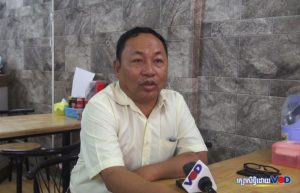
Professor Chey Thavy says, “Yes, that’s correct. The soil will become hard, and animals like earthworms and mole crickets all die. This is similar to the Kratie case. Paraquat is used in Kratie. People are poisoned due to the flow of the grass-killing chemical into the water source with high concentration and that’s harmful.”
The Paraquat substance kills green plants very fast, whatever species they belong to. It is also a type of chemical substance that poisons humans and animals because the substance rids oxygen.
Many developed countries in Europe such as Sweden, Switzerland and Germany have banned the use of this type of chemical substance while some other countries allow its use under the strictest law.
Thai’s The Nation published an article in March that Thai agricultural chemical experts have requested the Thai government to stop the use of Paraquat chemicals after a scientific study has found that the chemical is linked to the cause of diseases in humans, food contamination and impeding children’s development.
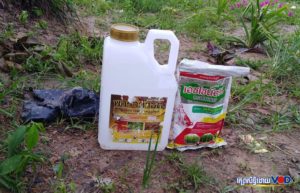
A new research conducted in 2011 by a group of researchers at the National Institute of Science and Environmental Health based in Maryland, USA, has found that the use of Paraquat and another agricultural chemical called Rotenone can be a cause of Parkinson’s disease.
The research has been conducted on 110 Parkinson patients and 358 other people who have never been exposed to any of the both types of agricultural chemicals. It was found that people who have been in contact with either of the two agricultural chemicals are two times more likely to get Parkinson’s disease than those who have never been in contact with the two agricultural chemicals.
The Head of the Neurological Operations Department at Phnom Penh Cho Ray Hospital, Dr. Kim Roeung, says that Parkinson’s disease in humans causes shaking hands or legs or slowness in movement due to a loss of Neurons which are located in the human brain.
Dr. Kim Roeung says, “Parkinson’s disease occurs on elderly aged 60 or over because brain cells are starting to fade. They get older than their real age. Symptoms include shaking and slow movement. To make it easy to understand we call it a disease of losing brain cells or brain cell damage or being older than the real age.”
Dr. Kim Roeung further explains that the “Initial symptom is that the patient has stiff arms or legs. Then, the patient experiences tremor or shaking of the arms. Even when they rest and do not do anything, this tremor or shaking occurs also. The tremor not only happens when working but also when not. A tremor may start in one arm and then spread to the other arm or it may start in one leg and then spread to the other leg. It depends on how severe the damage of the brain cells is.”
He adds that besides old age, over-use of the brain and lack of sleep, exposure to or inhaling of agricultural chemicals may also contribute to speedier loss of the neurons making humans become older than the real age.
Dr. Kim Roeung says, “Paraquat is harmful. If we use this chemical in the long run, it will be more likely to affect our health including the brain cells, making us forgetful. It may cause liver and kidney to become functionally weak. So, if farmers who use this chemical don’t protect themselves, they risk many diseases and it also affects the brain, the memory and the Neurons. It may cause many diseases. It may cause liver cancer and intestinal cancer. In Cambodia, we now have more cases of diseases like these.”
Dangers of agricultural chemicals and fertilizers controllable
Agriculture experts say the danger of agricultural chemicals and fertilizers can, in fact, be reduced or contained through the enforcement of laws and technical compliance for the use of such agricultural chemicals and fertilizers.
Dr. Cheang Hong, Dean of Faculty of Agronomy Science at the Royal University of Agriculture, says whatever types of agricultural chemicals and fertilizers, if they are used improperly and excessively, will become harmful to plants, animals and humans.
Dr. Cheang Hong says, “It depends on whether it is properly or improperly used. For chemicals, it is not about toxicity but it’s about the dose that may cause harm. The dose is the level of use. Too little or too much. There are safe doses and harmful doses. This is my understanding. For all chemicals, there is a certain dose that is safe and a certain dose that is harmful.”
Mrs. Tong Chantheang, Executive Director of the Cambodian Center for Study and Development in Agriculture (CEDAC), says in addition to ensuring technically proper use, the shift from agricultural chemicals and fertilizers to the organic ones is one of the best ways that won’t be harmful to people’s health, and it does not harm the underground and water ecological systems.
She adds that the enforcement of the laws by agricultural officials would improve the control and prevention of the import of agricultural chemicals and fertilizers banned by the Ministry of Agriculture, Forestry and Fisheries.
Mrs. Tong Chantheang says, “If the government already imposed a ban, the import is illegal. So, there must be strict control of retail shops. If banned substances are still being used, it means that they are still being imported illegally. So, it’s the job of the law enforcement officers to take action. If the government already bans or instructs not to use something but people still use it, this is illegal.”
Head of the Legislation Bureau of the Agriculture Mr. Suong Tev who has monitored the use of agricultural chemicals and fertilizers in some economic land concessions says he and his team would go to visit those economic land concessions in Seda commune to monitor the use of agricultural chemicals and fertilizers there.
Mr. Suong Tev says, “I will make a plan to visit them. I will contact the district office chief to ask how many companies there are that use agricultural chemicals and fertilizers and I will make a report on the situation. I will ask the office chief to arrange for meetings with the companies.”
He added that in order to enter the ELCs, he must seek facilitation from the owner of the ELC first.
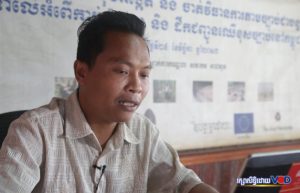
However, coordinator for human rights group ADHOC in Ratanakiri Mr. Khorn Khonny has questioned the effectiveness of the checking for illegal use of agricultural chemicals and fertilizers in ELCs if the agricultural officials needed to seek facilitation from the owners of the concessions.
Mr. Khorn Khonny says, “If the ministry officials make visits to investigate in an open manner; for an instance, letting the sellers or the company or the private plantations owner know in advance of the visits, it is no different than telling them to hide the evidence, and if the chemicals or fertilizers are known by the users that they are fake, then it is even easier for the sellers to destroy the evidence.”
A study found almost no positive from ELCs
A scientific study was conducted by Save Cambodia’s Wildlife in 2015 and released in early 2016. The study focused on the indigenous people living nearby ELCs in Virak Chey National Park and Lumphat Wildlife Sanctuary.
The study has found that the indigenous people who have responded said almost all ELCs have had adverse impacts on their social-cultural life and the economy of the indigenous people.
The same study has also found that the granting of ELCs to private companies under the government’s policy has had negative impact on the environment as well.
The study provided recommendations to the government, both at national and local levels, as well as private companies receiving ELCs.
Putting in place a mechanism to monitor and evaluate environmental impact is one of the four recommendations to the national government.
The study also said that a mechanism to monitor and evaluate the environmental impact would help the local indigenous communities to be informed of the impacts that may happen so that measures could be taken to minimize those impacts.
Note: Official report is in Khmer version is posted on VOD news website. Click this link: https://goo.gl/5ciYmg
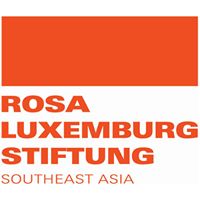 This report is published with the support of Rosa Luxemburg Stiftung with financial means of the Federal Ministry of Economic Cooperation and Development and not for sale.
This report is published with the support of Rosa Luxemburg Stiftung with financial means of the Federal Ministry of Economic Cooperation and Development and not for sale.

